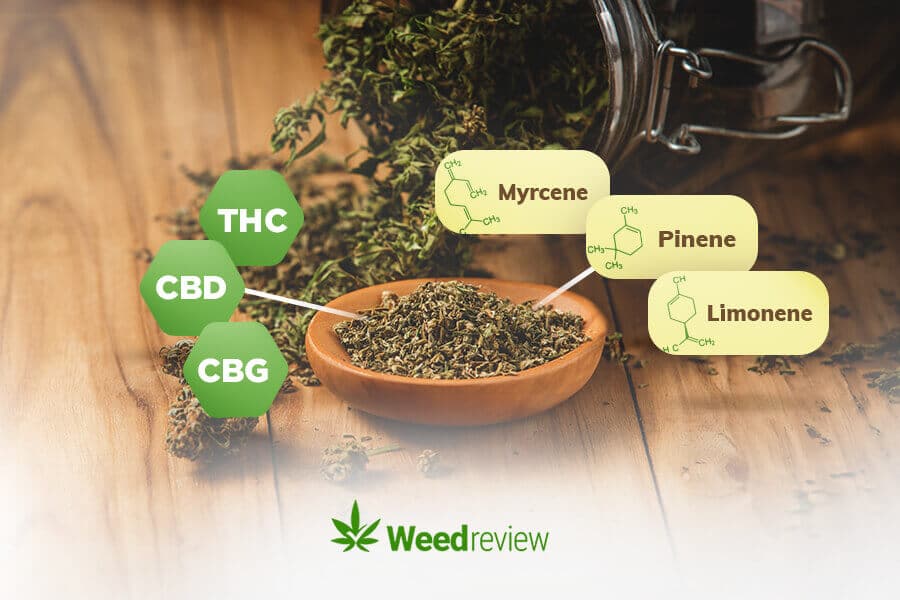
Entourage Effect in Cannabis: Mechanisms, Proof, Role of Terpenes

Table of Contents
More and more people are using medical cannabis as an alternative therapy to find comfort from symptoms like pain and sleep. Central to this therapeutic exploration is the entourage effect, a concept that wields great influence over these medicinal attributes.
Cannabis has lots of different parts in it, like cannabinoids and terpenes. When these parts all work together, they make the effects of cannabis stronger. But if you use just one part by itself, it doesn’t work as well because some important stuff is missing. This concept of synergy forms the core of the entourage effect.
We will explore this phenomenon in detail in this article. You will find everything you need to know about the entourage effect and how it shapes the medical potential of marijuana.
What is the entourage effect?
Imagine your body as a finely tuned orchestra, and the compounds in cannabis are like different instruments. When you take marijuana, you’re introducing hundreds of these compounds to your body. Each compound, like a unique musical instrument, has its own distinct qualities and effects.
Now, inside your body, there’s something called the Endocannabinoid System (ECS). Think of it as the conductor of the orchestra, guiding the interactions between these compounds and your body’s receptors. When these cannabis compounds—such as cannabinoids and terpenes—interact with the receptors in the ECS, they create various effects. This is similar to how different instruments playing together in harmony create a beautiful musical symphony.
Individually, each compound has its own role to play. Cannabinoids, for instance, can help with pain relief, relaxation, and more. Terpenes, on the other hand, are responsible for the distinct aroma and flavour of different cannabis strains and can also influence the effects you feel.

The magic truly happens when these compounds work together. When cannabinoids, terpenes, and other compounds are combined, their synergy creates a unique and often stronger effect than if they were used alone. This combined effect is what’s known as the entourage effect.
The origins of the effect
Dr. Ethan Russo, a respected neurologist and researcher, has been a pioneer in exploring the entourage effect of cannabis. His groundbreaking research, titled ‘Taming THC‘, has given us a deeper understanding of how cannabinoids, terpenes, and even flavonoids—the different “musical notes” of the cannabis plant—interact with each other and with our bodies.
Through his meticulous work, Dr. Russo has established that cannabinoids are more than isolated actors; they are part of a dynamic ensemble. They work with the body’s receptors, often producing effects beyond what a single cannabinoid could achieve.
Let’s explore this in detail below.
The proof of entourage effect
There is some scientific evidence to support the entourage effect.
- Research from a 2010 medical study displayed some of the earliest proof of the theory. Cancer patients were given either THC or a product with almost equal parts THC and CBD. As it turns out, the results showed that the patients who were given both cannabinoids experienced less pain than those who just took the THC.
In this case, the research suggests that THC and CBD worked better together than separately at addressing the targeted symptoms. While the two biggest cannabinoids take all the credit, it is clear that cannabis is much more than just THC and CBD.
- Another study done in 2020 emphasizes the potential of minor cannabinoids and terpenes in contributing to the therapeutic aspects of cannabis use.
This research also indicates that the synergy of cannabinoids, terpenes, and flavonoids can potentially produce a broader therapeutic profile, offering enhanced health benefits compared to using cannabinoids alone.
The role of terpenes
Terpenes are the other part of the entourage effect puzzle. There are over 200 of these aromatic chemicals in weed, and they determine the taste and smell of cannabis flowers.
More importantly, they also determine how th experience of the given marijuana strain will be. Here are a few studies to back this claim:
- For example, research suggests that a pinene-dominant strain could increase the effects of the THC content inside the weed. This would be far more effective for a customer to know for targeting pain symptoms than simply knowing that their weed is an Indica strain.
- Another study shows that limonene, a citrus-flavoured terpene, had anti-anxiety and antidepressant properties in rodent subjects. This could potentially increase the mentally uplifting effects of CBD & THC.
- Similarly, myrcene is another well-known terpene that is famous for its sedating and sleep-inducing properties. Therefore, strains rich in myrcene – like Northern Lights or Granddaddy Purple – will help you sleep better.
In simple terms, terpenes are like secret helpers in cannabis, not only giving it its smell and taste but also teaming up with other stuff in cannabis to make us feel things emotionally and physically.
What about flavonoids?
Flavonoids are a group of naturally occurring compounds found in a wide variety of plants, including cannabis. They are known for their potential health benefits and are being studied for their antioxidant, anti-inflammatory, and other therapeutic properties.
While the entourage effect is often associated with cannabinoids and terpenes, some research suggests that flavonoids may also play a role in this phenomenon. Flavonoids can interact with other compounds in the cannabis plant and potentially influence the overall effect and therapeutic benefits. However, compared to cannabinoids and terpenes, the research on the specific contributions of flavonoids to the entourage effect is more limited.
Chemovar classification: The building blocks of the entourage effect
Chemovar classification, or chemotypes, refers to the categorisation of cannabis strains based on their chemical properties, such as cannabinoids and terpenes. This serves as a more practical proof of the entourage effect in action.
The chemovar classification system provides a more accurate understanding of the potential effects and therapeutic properties of different cannabis strains.
You see, most people currently understand the effects of marijuana by thinking of them in three cultivars: Indica, Sativa, and hybrids. However, classifying them by their terpene and cannabinoid pairings would provide more information on what that strain could effectively target. This would help give the customer a more accurate representation of what the product can do.
This would explain why you could have a strain such as Northern Lights and Jack Herer that might have similar THC content but provide different effects.
Northern Lights has myrcene, known for its relaxing effects, while Jack Herer has limonene which elevates your mood. The terpenes within and the concentration of them will alter the overall effects of the cannabinoids.
The entourage effect and cannabis spectrums
Another practical aspect of the entourage effect is seen when you go to buy cannabis extracts & oils.
Cannabis extracts come in three types: full-spectrum, broad-spectrum, and isolates.
The cannabis spectrum you choose will determine the chance of experiencing the entourage effect. For example, using an isolate won’t promote the entourage effect because it contains only one cannabinoid, whereas a full-spectrum product will.
- Full-spectrum: These extracts encompass all cannabinoids and terpenes in cannabis, promising a wide range of therapeutic effects and the strongest potential for the entourage effect. Suitable for tinctures, edibles, and oils, they maintain prolonged activity in the bloodstream, but remember, they contain THC, which can induce sedation.
- Broad-spectrum: Similar to full-spectrum but without THC, these extracts retain terpenes and numerous cannabinoids. Designed for those seeking the entourage effect minus THC’s psychoactivity, they’re used in edibles, tinctures, and oils. More research is needed on potential changes post-THC removal.
- Isolate: Isolates focus on a single compound, like CBD or THC. They blend into edibles, capsules, and topicals. CBD isolates cater to those avoiding other compounds, while THC isolates simplify dosing. Remember, isolates lack the collaborative entourage effect due to their solitary nature.
Conclusion
While the idea of the entourage effect is widely talked about in the cannabis community, it’s important to know that there isn’t a lot of solid scientific proof for it yet. Still, early studies and stories from people using cannabis show that it might help make cannabis therapy even better.
The entourage effect explains why different types of cannabis can give different effects, even if they have the same THC. This is because of the special mix of stuff like cannabinoids and terpenes in each type.
It’s why full-spectrum products, with lots of these compounds, are thought to be the best for specific health issues. More research on the entourage effect could change the way we use cannabis for health reasons in the future.
Explore our collection of legal cannabis products on Weed Review if you’d like to experience the entourage effect yourself.


